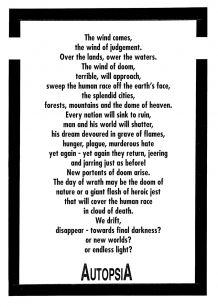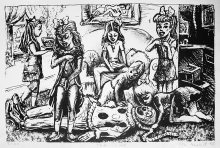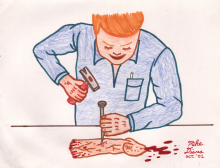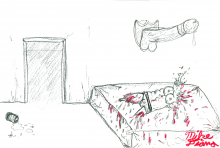| Revista Umělec 2000/4 >> Bondage de Luxe. A Few Notes on One Taboo in Modern Culture | Lista de todas las ediciones | ||||||||||||
|
|||||||||||||
Bondage de Luxe. A Few Notes on One Taboo in Modern CultureRevista Umělec 2000/401.04.2000 Otto M. Urban | taboo | en cs |
|||||||||||||
|
To Veronika Bromová
“And I handed him a reel of strong, sixty-meter-long rope.” Comte de Lautréamont I. Bondage is always about constriction. Humankind has constricted the body from time immemorial. Throughout history somebody has always had to be tightly bound. People have bound men, women, children, murderers, saints, heretics, fools, and heroes. And there just as many ways and even “schools” teaching how to bind and constrict. Prometheus, Jesus Christ, Saint Sebastian, Jan Hus, Gilles de Rais, Giordano Bruno, Marquis de Sade and many others were all bound up. Furthermore millions of women, labeled as witches, were confined to pillories and then burnt to death across all of Europe. Literature describes hundreds of cases of witches apparently demanding tighter constraints because they considered pain delightful. Rumor had it that they also managed to leave the bound body to take part in orgiastic Sabbaths even during their trials. Modern times have changed our attitudes towards bondage as we gradually work our way down from pillories on public squares. A confined person is no longer displayed in public places like a trapped animal. All this has moved behind the impervious walls of penitentiaries, jails, schools, psychiatric clinics, military barracks, churches, and various chapels while moving at the same time into intimate bedrooms and boudoirs. The theme of bondage has also appeared in a number of works of art. Since Flowers of Evil by Charles Beaudelaire or, if you like, the works of Marquise de Sade, the pain connected to sexuality has become an important part of European thinking. II. Bondage represented severe punishment because a confined person was totally humiliated and absolutely incapable of a natural existence. It is, however, often the case that such limitation is voluntary. Bondage in connection to sexuality therefore represents a significant theme in modern psychology and psychoanalysis. Freud wrote that psychoanalysis formulated elementary theories concerning masochism and sadism, which are directly connected to bondage.1 The division, however, is not all that unambiguous. Masochism is not only perceived as an expression of weakness and submission but also as a potential expression of inner strength and determination. In his major essay “Le Froid et le Cruel” (1967) Gilles Deleuze analyzes in detail the book Venus in Furs by Leopold von Sacher-Masoch and the theme of masochism has been part of a number of other essays.2 Masochism is also interpreted as the strength to show weakness or as a certain physical redemption of the urgent mental feeling of guilt. The combination of strength and power continues to come up in essays on bondage. III. A Tokyo-based magazine inspired the title of this text. As the name Japan Bondage de Luxe explicitly suggests, the magazine is concerned with bondage practices—a field based directly on confinement and constriction. Bondage is associated with fetishism and, naturally, sadism and masochism. As the Japanese magazine reveals, however, bondage also embodies visual and esthetic dimensions such as the precision of knots and loops, the exact placement of rope on a specific place, order and system so complex and broad that its relations go beyond mere sexuality. The entire magazine lacks all text, credits, and masthead; no primitive or vulgar stories complement the photographs. The reader must communicate with them directly using traditional symbolism. Although their authors are not credited, the photographs transcend the common pornographic routine. They are in fact closer to the works of artists like Eric Kroll, Doris Kloster, and Gary & Pierre Dilva. The precision of lines suggests the simplicity of Japanese drawings, which fascinated Europe in the second half of the 19th century, and were some of the most inspirational influences for the language of art nouveau. The line also bound the liberal turn of the century to various forms: the peak of corset fashion, the expanding railway network, posters by Alfons Mucha, Carlos Schwabe, paintings by Jan Toorop and Johann Thorn Prikker, drawings by Aubrey V. Beardsley, jewels by René Lalique, architecture by Antoni Gaudí, and wireless telephone connections. IV. Over the past few decades, bondage has given rise to a distinctive subculture connecting a wide range of people. The Internet offers hundreds of websites concerning this theme.3 One example is the monthly magazine Submissive Sluts, which belongs to the production of hardcore bondage. In this magazine too no text accompanies the photographs but as far as design goes it is a second-rate publication with mostly black and white images. The stories take place in artistically decorated interiors, but they focus more on violence and pain than on the artistic and decorative qualities of knots and lines of rope. The magazine emphasizes the atmospheric environment in which the bondage is taking place. Large black irregular circles, which are supposed to symbolize the circumference of stones, immediately evoke a constricted atmosphere, some kind of medieval torture chamber. Some of Otto Dix’s drawings from the beginning of the 1920s suggest similarly straightforward, raw atmospheres. His watercolor entitled Dream of a Sadist II (1922) shows a whole range of motifs directly linked to constriction and bondage. In fact they go beyond the imagery in Submissive Sluts. Dix is more aggressive; for him the human body is an object, matter. The work is about the clear division of roles, about who binds and who is bound. He is also more straightforward and more open about sexuality. In this sense bondage also asserts a certain mental and social state in society. Only a few years later, Max Beckman painted Night, symbolically illustrating the atmosphere of violence and perversion in post-war Berlin. V. Bondage practices in fact represent a certain kind of game or performance with fixed rules. A number of performance artists and body artists work with the theme of constriction and limitation. Fakir Musafar was one of the pioneers of body art, relating his work to masochism. In his interpretation however masochism was not treated negatively like a weakness. In an interview with Kristine Ambrosia and Joseph Lanz,4 Musafar interpreted masochism as a positive term “which is perceived in a negative way by our culture.” His project Suspension (1964) shows the ambivalence in the perception of submissiveness. Musafar explained his actions as a natural external presentation of his personality. He criticized Stelarc for his “excessive belief in new technology.” Constriction and piercing for Musafar represented a mystical, religious act not primarily based on sexuality. The motif of the constriction of the body by leather bands brings to mind the recent project Zemzoo (1998) by Veronika Bromová where she constricted the body with clear tape. And, as in her series Views, she observes her own identity. Instead of revealing the inner reality of the body, however, she deforms it through constriction. The imagery is visually highlighted by the body’s reflection in silver foil as the glossy surface further deforms what has already been deformed. Neither Musafar nor Bromová destroys their bodies. Instead they explore and analyze their physical experience. Zemzoo was also concerned with isolation as was her New York project Parts of Me, Parts of NYC. VI. Constricting the body is both limiting and separating. The photographic portrait of David Wojnarowicz from his project Silence=Death (1990) shows his face with his lips sewed closed with gray thread. At that time Wojnarowicz had already become an icon, and both his artwork and his own existence were seen as two integral values. In the photograph, Wojnarowicz, one of the most radical critics of American society in the 1980s, is looking into our faces but he can’t speak because his mouth is sewed closed. What’s going on here? This is one of modern art’s most effective portraits. Physical bondage represents a significant mental symbol, often exceeding the sexual realm. Bondage as an expression of self-destructive anxiety stemming from personal identity was also inherent in central European art around the turn of the 19th century. The artist often identified with religious figures, mainly Christ and other martyrs. In one striking example, Jan Zrzavý associates himself with the crucified in his painting Antichrist (1910). The picture was made during Zrzavý’s period of self-doubt. He symbolically condemned himself to terrifying physical torture. He was misunderstood as a painter, rejected by his family, and he had to deal with issues related to his homosexuality. Thanks to Bohumil Kubišta he was able to overcome this crisis. Similarly effective is Bohumil Kubišta’s self-portrait entitled Saint Sebastian (1912). Kubišta symbolically accepted the guilt of other modernists in their conflict with the art world. He was bound and his body was clawed to prove the strength of his belief in modernism. From the perspective of the intellectual Catholic orthodoxy, Sebastian’s act was beautiful. In this sense a remarkable painting by Guido Reni is noteworthy. Oscar Wilde was fascinated by this picture because of the contrast between the cruelty and horror of the theme and the handsome young body of the man: pain as a prerequisite to understanding beauty. VII. The work of Pierre et Gilles represents a similar notion. Their bound men are also beautiful. Their version of Saint Sebastian is bound by the vines of the crimson rambler while their double portrait Totem doesn’t even show the bonds. The contrast between the beautiful form and the dramatic nature of the theme caused harsh criticism and rejection. Imagery of death and pain is supposed to be expressive, drastic in late Gothic style, and cruelly emotional. The security of kitsch is considered inappropriate. As Reni’s paintings prove, imagery of the constricted body was not (or is not) only a subject of modern art. VIII. The sphere of erotic literature and magazines has been expanding since the 1920s. However prevalent explicit photography has become, works of art remain popular. For example, drawings by John Willie, cooperating with the American magazine Bizzare, are valuable collector’s items. Willie’s women were beautiful, seductive, and confined. They represented a non-existing ideal. Of special interest are also comic books specializing in bondage. The bound women who penetrated Hollywood always bore an erotic subtext. The viewer identified with the hero and wanted to save the bound heroine from the dangerous situation she found herself in. Cecil B. De Mille’s film entitled The Sign of the Cross (1932) had a scene with a naked Christian woman awaiting death in an arena. The motif of confinement later appeared in hundreds of films. Even the end of the millenium has its own famous bound heroes. As global communication blurred the boundaries between reality and fiction, we had an opportunity to witness Guzmán, James Bond, Carlos, Hannibal Lecter, Carlos and Lara Croft.5 And yet one of the first instances of bondage was the Hellenistic statue Laokoon. Laokoon was a Trojan priest who warned his fellow citizens not to let a Greek wooden horse—a sacrifice to the Goddess Minerva—into the city. Furious, the Goddess bound Laokoon and his two sons’ bodies with two huge snakes. The frightened Trojans then let the horse into the city. Translated by Vladan Šír Notes: 1. Sigmund Freud, A Child as being beaten. in: Standard Edition of the Complete Psychological Works of Sigmund Freud. London 1953-1974, pp. 179-204. The Economic problem of Masochism. in: Standard Edition of the Complete Psychological Works of Sigmund Freud. London 1953-1974, pp. 159-170 2. Of importance are also texts by Georges Bataille such as his book L‘Erotisme, Paris, 1957. One of the most interesting recent books is Suzanne R. Stewart’s, Sublime Surrender, Male Masochism at the Fin de Siecle, Ithaca and London, 1998. 3. A number of links are quite intellectual in nature, i.e.: www.bondage-sex-stories.cx/ or www.bdsm-spanking-stories.com 4. Fakir Musafar Interview, in: Apocalypse Culture (Adam Parfrey ed.) New York 1987, pp. 105-114. 5. One of the few recently published texts on pop culture and bondage practices published in Czech: Jiří ”Maus” Šimáček, Síťové speciality, Živel 10, 1998, pp. 78-79. "
01.04.2000
Artículos recomendados
|
|||||||||||||
|
04.02.2020 10:17
Letošní 50. ročník Art Basel přilákal celkem 93 000 návštěvníků a sběratelů z 80 zemí světa. 290 prémiových galerií představilo umělecká díla od počátku 20. století až po současnost. Hlavní sektor přehlídky, tradičně v prvním patře výstavního prostoru, představil 232 předních galerií z celého světa nabízející umění nejvyšší kvality. Veletrh ukázal vzestupný trend prodeje prostřednictvím galerií jak soukromým sbírkám, tak i institucím. Kromě hlavního veletrhu stály za návštěvu i ty přidružené: Volta, Liste a Photo Basel, k tomu doprovodné programy a výstavy v místních institucích, které kvalitou daleko přesahují hranice města tj. Kunsthalle Basel, Kunstmuseum, Tinguely muzeum nebo Fondation Beyeler.
|


































 New book by I.M.Jirous in English at our online bookshop.
New book by I.M.Jirous in English at our online bookshop.
Comentarios
Actualmente no hay comentariosAgregar nuevo comentario